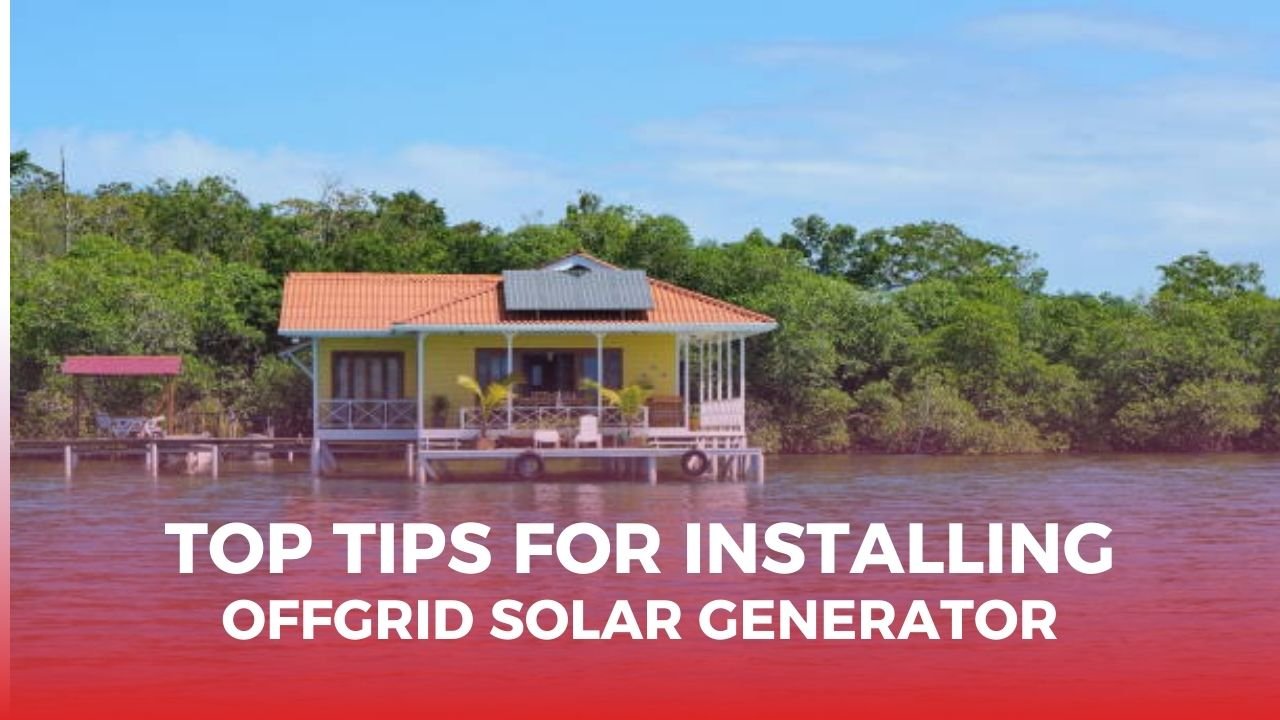Top tips for Installing an offgrid solar generator entails relying solely on solar energy to power your home or remote location independently of the grid. This process involves capturing sunlight through photovoltaic panels, storing excess energy in batteries, and converting it into usable AC power through an inverter.
Assessing Your Energy Needs
Before diving into solar system installation, it’s crucial to calculate your household’s daily energy consumption. This step helps determine the appropriate size and capacity of the system required for your specific needs.
Consider not just the baseline consumption but also peak loads—those times when appliances with high energy demands, such as refrigerators or water pumps, are in use. These factors significantly influence the size of your system and the battery requirements.
Choosing the Right Solar Components
When selecting solar panels, opt for high-efficiency options that are suitable for offgrid setups. Monocrystalline panels are particularly noteworthy due to their efficiency and space-saving qualities, making them ideal for locations with limited roof space.
For batteries, the choice between lead-acid and lithium-ion depends on your budget and longevity requirements. Both offer distinct advantages, so it’s important to weigh these factors carefully.
Placement and Orientation
The placement of solar panels is critical to maximizing energy capture. Install them where they receive maximum sunlight exposure throughout the day. In the Northern Hemisphere, this usually means facing panels southward, while in the Southern Hemisphere, north-facing orientation is optimal.
Adjust the tilt of your panels to optimize solar exposure based on your location’s latitude, accounting for seasonal variations in the sun’s angle.
Safety Considerations
During installation, prioritize electrical safety by ensuring that all components meet relevant safety standards. Use insulated tools and consider engaging a certified electrician for wiring connections to minimize risks.
Additionally, guard against potential fire hazards by incorporating protective measures such as fuses and proper ventilation for batteries.
Wiring and Connection Tips
To minimize power loss over distances between components, select wiring with an appropriate gauge. Ensure all connections are securely tightened and insulated to prevent moisture ingress or accidental disconnections.
Battery Bank Setup
Understand the differences between series and parallel connections when configuring your battery bank. This knowledge is crucial for achieving the desired voltage and capacity.
Install batteries in a cool, well-ventilated area with adequate containment to safeguard against damage and optimize performance.
Inverter Installation
When selecting an inverter, consider its size relative to your system’s AC load requirements. Pure sine wave inverters are preferable for sensitive electronics. Adhere to local electrical codes when integrating the inverter with your home’s electrical panel for seamless operation.
Monitoring and Maintenance
Regularly monitor system performance using appropriate tools to track energy production, battery status, and overall system health. Implement scheduled maintenance checks on panels, batteries, and connections to identify and address issues promptly.
Testing and Troubleshooting
After installation, conduct comprehensive tests to verify proper system functionality under various load conditions. Familiarize yourself with common issues such as wiring faults or battery malfunctions and learn effective troubleshooting techniques.
Optimizing Energy Efficiency
Implement energy-efficient practices such as load management to prioritize high-energy tasks during peak solar production hours. Consider expanding your battery bank capacity to store excess energy for periods of reduced sunlight.
Common Mistakes to Avoid
Ensure solar panels remain unshaded throughout the day to maximize solar intake. Overestimate rather than underestimate your energy requirements to avoid system underperformance.
Budgeting and Cost Considerations
Plan your budget carefully, factoring in initial setup costs, including equipment and installation expenses, alongside potential rebates or incentives that can offset these costs. Calculate long-term savings from reduced utility bills and maintenance expenses over the system’s lifespan.
Environmental Impact
Switching to solar power reduces reliance on fossil fuels, thereby lowering greenhouse gas emissions and supporting renewable energy initiatives. Embrace offgrid solar solutions as a sustainable step towards minimizing your carbon footprint.
Final Though Top Tips for Installing Your Offgrid Solar Generator
Installing an offgrid solar generator empowers you to harness clean energy independently. By following these comprehensive guidelines, you can navigate the installation process confidently, ensuring efficient performance and long-term sustainability for your home or remote location.
Frequently Asked Questions
- How do I determine the right size for my offgrid solar system?
- Calculate your daily energy consumption and factor in peak loads to select appropriate panel and battery capacities.
- What maintenance does an offgrid solar system require?
- Regularly monitor panel cleanliness, battery charge levels, and system connections. Perform periodic checks for debris, corrosion, or wiring issues.
- Can I expand my offgrid solar system in the future?
- Yes, you can expand your system by adding more panels or batteries. Ensure your charge controller and inverter can accommodate the increased capacity.
- How long do batteries in an offgrid solar system last?
- Battery lifespan typically ranges from 5 to 15 years, depending on usage, maintenance, and type (lead-acid vs. lithium-ion).
- Are there government incentives for installing offgrid solar systems?
- Check with local authorities for incentives such as tax credits or rebates that promote renewable energy adoption and offset installation costs.
Crafting an offgrid solar system requires meticulous planning and execution to maximize benefits. By integrating these tips into your installation process, you’re not only enhancing your energy independence but also contributing to a sustainable future. Whether for remote living or reducing your carbon footprint, embracing solar power is a positive stride forward.





![EcoFlow Delta 1800W / 1300wH + RIVER600 [1548wh Kit]](https://i0.wp.com/portablepowerusa.com/wp-content/uploads/2021/03/EcoFlow-Delta-1800W-1300wH-RIVER600-1548wh-Kit.png?resize=300%2C300&ssl=1)














